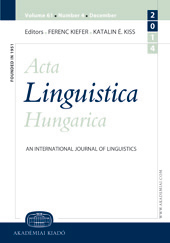Morphopragmatic phenomena in Hungarian
Morphopragmatic phenomena in Hungarian
Author(s): Ferenc KieferSubject(s): Morphology, Pragmatics, Finno-Ugrian studies
Published by: Akadémiai Kiadó
Keywords: morphology; morphology; modality; pragmatics; diminutives; the expressive;
Summary/Abstract: Morphopragmatics is defined as the relationship between morphology and pragmatics, in other words, it investigates pragmatic aspects of patterns created by morphological rules. The paper discusses three morphopragmatic phenomena in Hungarian. The first one concerns the use of the excessive which does not add semantic information to the superlative and carries purely pragmatic information. It is used to express the highest possible degree of some property and it carries the conversational implicature that the speaker wants to draw the listener's attention to the importance of what he is saying. The second problem discussed has to do with the pragmatics of the diminutive suffix. The semantic meaning of the diminutive suffix is `small' or `a little' (the latter occurs with mass nouns), which, however, is often overridden by the pragmatic meaning. In most cases, the use of the diminutive signals a positive emotional attitude, but it may carry a pejorative meaning, too. Finally, the third phenomenon concerns the pragmatics of the possibility suffix -hat/-het. From among the various pragmatic meanings the deontic speech acts are well known from other languages. There are, however, several other uses which seem to be typical of Hungarian. Two of these are particularly interesting: (a) the context may turn possibility into necessity, (b) the verb mond `say, tell' suffixed by the possibility suffix may carry the pragmatic meaning `say/tell in vain'. In addition to these two uses, several others will be discussed.
Journal: Acta Linguistica Hungarica (Since 2017 Acta Linguistica Academica)
- Issue Year: 51/2004
- Issue No: 3-4
- Page Range: 325-349
- Page Count: 25
- Language: English

